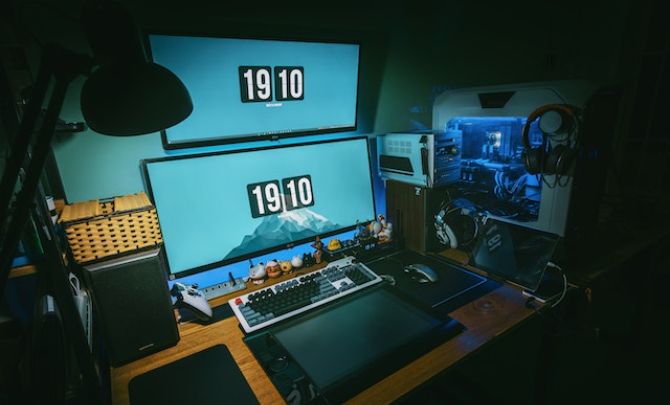The gaming industry has witnessed remarkable advancements in recent years, revolutionizing the way people engage with interactive entertainment. One key technology driving this transformation is Programmable Logic Arrays (PLAs). In this article, we will explore the profound impact of PLA on the gaming landscape, highlighting how it is reshaping the industry and paving the way for a future of immersive gaming experiences. To effectively invest in Bitcoin trading, you must have a reliable trading platform such as immediate-edge.pl.
The Rise of Programmable Logic Arrays (PLAs)
Understanding Programmable Logic Arrays (PLAs)
At its core, a Programmable Logic Array (PLA) is a digital integrated circuit that enables developers to design and implement customized logic functions. PLAs consist of an array of programmable AND gates, followed by an array of programmable OR gates. This architecture allows for the creation of complex digital circuits and logic functions tailored to specific requirements.
Advantages of PLAs in Gaming
- Flexibility and Customization: PLAs offer game developers unparalleled flexibility and customization options. By leveraging PLAs, developers can design intricate game logic, define specific rules and interactions, and create unique gameplay mechanics that cater to diverse player preferences.
- Rapid Prototyping and Iteration: The programmable nature of PLAs enables rapid prototyping and iteration in game development. Developers can experiment with different logic configurations, test various gameplay mechanics, and refine their designs efficiently. This iterative process ultimately leads to enhanced gaming experiences.
- Efficient Resource Utilization: PLAs allow for efficient resource utilization, optimizing both hardware and software components. By fine-tuning the logic circuits, developers can minimize hardware requirements, reduce power consumption, and maximize performance, ensuring smoother gameplay and immersive graphics.
- Scalability and Future-Proofing: With PLAs, game developers can design games that are scalable and future-proof. They can easily adapt the logic functions to accommodate evolving technologies, hardware platforms, and player demands, providing a seamless experience across different gaming devices and platforms.
Transforming the Gaming Industry
Enhancing Gameplay Experiences
PLAs have played a pivotal role in enhancing gameplay experiences across various genres. Here’s how PLAs have reshaped different aspects of the gaming industry:
- Realistic Environments and Physics: With the power of PLAs, game developers can create realistic environments and physics simulations that add depth and authenticity to gameplay. From accurately modeling the behavior of water and fire to simulating complex physics interactions, PLAs enable lifelike experiences that immerse players in virtual worlds.
- Dynamic AI and Non-Player Characters (NPCs): PLAs have revolutionized the behavior of AI-controlled non-player characters in games. By utilizing advanced logic functions, developers can design dynamic AI systems that react intelligently to player actions, creating more challenging and engaging gameplay scenarios.
- Procedural Generation: PLAs have facilitated the adoption of procedural generation techniques in game development. Developers can use PLAs to generate dynamic and infinitely varied game content, including terrain, levels, quests, and items. This approach adds replay value and eliminates the need for extensive manual content creation, reducing development time and costs.
- Immersive Storytelling: PLAs have empowered game developers to craft immersive narratives and compelling storylines. By implementing complex decision trees and branching narratives, developers can offer players meaningful choices that shape the outcome of the game, resulting in immersive storytelling experiences.
Expanding Gaming Platforms
PLAs have contributed to the expansion of gaming platforms, allowing games to reach wider audiences and transcend traditional boundaries:
- Mobile Gaming: With the proliferation of smartphones and tablets, PLAs have enabled the development of graphically-rich and immersive games for mobile platforms. The efficiency and scalability of PLAs ensure smooth gameplay experiences even on devices with limited hardware resources.
- Virtual Reality (VR) and Augmented Reality (AR): PLAs are instrumental in pushing the boundaries of virtual reality and augmented reality gaming. By leveraging PLAs, developers can create realistic VR environments, implement responsive AR interactions, and deliver truly immersive experiences that blur the line between the real and virtual worlds.
- Cloud Gaming: PLAs play a vital role in the emerging field of cloud gaming. By offloading processing tasks to remote servers, PLAs enable high-fidelity gaming experiences on low-end devices. This approach democratizes gaming, allowing players to access graphically-intensive games without the need for expensive hardware.
Embracing the Future of Gaming
As the gaming industry continues to evolve, the impact of PLAs will become even more pronounced. Game developers and industry pioneers are actively exploring new possibilities and pushing the boundaries of what can be achieved with this powerful technology. With PLAs, the future of gaming holds tremendous promise:
- Hyper-Realistic Graphics and Physics: PLAs will continue to drive advancements in graphics rendering and physics simulations, bringing gaming experiences closer to reality than ever before. Players can look forward to breathtaking visuals, lifelike animations, and physics-based interactions that blur the line between virtual and real-world environments.
- Artificial Intelligence and Machine Learning Integration: PLAs will facilitate deeper integration of artificial intelligence and machine learning techniques in games. AI-driven NPCs will exhibit even more realistic behavior, adapting to player choices and creating dynamic and personalized experiences.
- Seamless Cross-Platform Gaming: With PLAs, the future of gaming will be characterized by seamless cross-platform experiences. Players will enjoy uninterrupted gaming sessions as they effortlessly transition between devices, carrying their progress and achievements across different platforms.
- Emerging Technologies: PLAs will continue to intersect with emerging technologies, such as blockchain, Internet of Things (IoT), and 5G connectivity. This convergence will unlock new opportunities for innovation, fostering the development of decentralized gaming ecosystems, connected gaming experiences, and ultra-low-latency multiplayer interactions.
Conclusion
The rise of Programmable Logic Arrays (PLAs) has ushered in a new era of gaming, revolutionizing the industry and paving the way for a future of unparalleled gaming experiences. The flexibility, customization options, and efficiency offered by PLAs have transformed gameplay mechanics, enhanced graphics and physics simulations, and expanded gaming platforms. As we embrace the future, PLAs will continue to shape the gaming landscape, enabling hyper-realistic graphics, AI-driven interactions, seamless cross-platform gaming, and exciting innovations fueled by emerging technologies. With PLAs at the forefront, the future of gaming is boundless.
